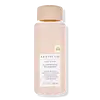What's inside
What's inside
 Key Ingredients
Key Ingredients

 Benefits
Benefits

 Concerns
Concerns

 Ingredients Side-by-side
Ingredients Side-by-side

Water
Skin ConditioningSodium Laureth Sulfate
CleansingCocamidopropyl Betaine
CleansingSodium Lauryl Sulfate
CleansingSodium Chloride
MaskingParfum
MaskingPhenoxyethanol
PreservativeSodium Sulfate
Glycerin
HumectantDisodium EDTA
PEG-4 Laurate
EmulsifyingPEG-4 Dilaurate
EmulsifyingCitric Acid
BufferingTetrasodium EDTA
Cetearamidoethyldiethonium Succinoyl Hydrolyzed Pea Protein
CleansingIodopropynyl Butylcarbamate
PreservativePEG-4
HumectantHypnea Musciformis Extract
Skin ProtectingSargassum Filipendula Extract
Skin ProtectingSorbitol
HumectantGelidiella Acerosa Extract
Skin ProtectingMethylchloroisothiazolinone
PreservativeCaprylic/Capric Triglyceride
MaskingChamomilla Recutita Flower Extract
MaskingHelianthus Annuus Seed Oil
EmollientMangifera Indica Seed Butter
Skin ConditioningPersea Gratissima Oil
Skin ConditioningRicinus Communis Seed Oil
MaskingMethylisothiazolinone
PreservativeCoco-Glucoside
CleansingEthylhexylglycerin
Skin ConditioningAlgin
MaskingCarrageenan
Chitosan
Guar Hydroxypropyltrimonium Chloride
Skin ConditioningSorbitan Oleate
EmulsifyingXanthan Gum
EmulsifyingLimonene
PerfumingCI 17200
Cosmetic ColorantWater, Sodium Laureth Sulfate, Cocamidopropyl Betaine, Sodium Lauryl Sulfate, Sodium Chloride, Parfum, Phenoxyethanol, Sodium Sulfate, Glycerin, Disodium EDTA, PEG-4 Laurate, PEG-4 Dilaurate, Citric Acid, Tetrasodium EDTA, Cetearamidoethyldiethonium Succinoyl Hydrolyzed Pea Protein, Iodopropynyl Butylcarbamate, PEG-4, Hypnea Musciformis Extract, Sargassum Filipendula Extract, Sorbitol, Gelidiella Acerosa Extract, Methylchloroisothiazolinone, Caprylic/Capric Triglyceride, Chamomilla Recutita Flower Extract, Helianthus Annuus Seed Oil, Mangifera Indica Seed Butter, Persea Gratissima Oil, Ricinus Communis Seed Oil, Methylisothiazolinone, Coco-Glucoside, Ethylhexylglycerin, Algin, Carrageenan, Chitosan, Guar Hydroxypropyltrimonium Chloride, Sorbitan Oleate, Xanthan Gum, Limonene, CI 17200
Water
Skin ConditioningTea-Lauryl Sulfate
CleansingGlycerin
HumectantDisodium Laureth Sulfosuccinate
CleansingSodium Lauryl Sulfoacetate
CleansingDisodium Cocoamphodiacetate
CleansingLauryl Betaine
CleansingGlycol Stearate
EmollientGlycolic Acid
BufferingButylene Glycol
HumectantPanthenol
Skin ConditioningSodium Sulfate
Sodium Chloride
MaskingHydroxypropyl Methylcellulose
Emulsion StabilisingMethylparaben
PreservativeGuar Hydroxypropyltrimonium Chloride
Skin ConditioningPropylparaben
PreservativeDisodium EDTA
Water, Tea-Lauryl Sulfate, Glycerin, Disodium Laureth Sulfosuccinate, Sodium Lauryl Sulfoacetate, Disodium Cocoamphodiacetate, Lauryl Betaine, Glycol Stearate, Glycolic Acid, Butylene Glycol, Panthenol, Sodium Sulfate, Sodium Chloride, Hydroxypropyl Methylcellulose, Methylparaben, Guar Hydroxypropyltrimonium Chloride, Propylparaben, Disodium EDTA
 Reviews
Reviews

Ingredients Explained
These ingredients are found in both products.
Ingredients higher up in an ingredient list are typically present in a larger amount.
Disodium EDTA plays a role in making products more stable by aiding other preservatives.
It is a chelating agent, meaning it neutralizes metal ions that may be found in a product.
Disodium EDTA is a salt of edetic acid and is found to be safe in cosmetic ingredients.
Learn more about Disodium EDTAGlycerin is already naturally found in your skin. It helps moisturize and protect your skin.
A study from 2016 found glycerin to be more effective as a humectant than AHAs and hyaluronic acid.
As a humectant, it helps the skin stay hydrated by pulling moisture to your skin. The low molecular weight of glycerin allows it to pull moisture into the deeper layers of your skin.
Hydrated skin improves your skin barrier; Your skin barrier helps protect against irritants and bacteria.
Glycerin has also been found to have antimicrobial and antiviral properties. Due to these properties, glycerin is often used in wound and burn treatments.
In cosmetics, glycerin is usually derived from plants such as soybean or palm. However, it can also be sourced from animals, such as tallow or animal fat.
This ingredient is organic, colorless, odorless, and non-toxic.
Glycerin is the name for this ingredient in American English. British English uses Glycerol/Glycerine.
Learn more about GlycerinThis ingredient is derived from guar gum.
It is a conditioning ingredient, meaning it helps soften skin and hair.
Chances are, you eat sodium chloride every day. Sodium Chloride is also known as table salt.
This ingredient has many purposes in skincare: thickener, emulsifier, and exfoliator.
You'll most likely find this ingredient in cleansers where it is used to create a gel-like texture. As an emulsifier, it also prevents ingredients from separating.
There is much debate on whether this ingredient is comedogenic. The short answer - comedogenic ratings don't tell the whole story. Learn more about comegodenic ratings here.
The concensus about this ingredient causing acne seems to be divided. Research is needed to understand if this ingredient does cause acne.
Scrubs may use salt as the primary exfoliating ingredient.
Learn more about Sodium ChlorideSodium Sulfate is a type of sulfate.
Water. It's the most common cosmetic ingredient of all. You'll usually see it at the top of ingredient lists, meaning that it makes up the largest part of the product.
So why is it so popular? Water most often acts as a solvent - this means that it helps dissolve other ingredients into the formulation.
You'll also recognize water as that liquid we all need to stay alive. If you see this, drink a glass of water. Stay hydrated!
Learn more about Water